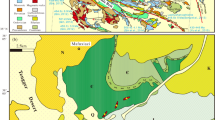Abstract
Late Mesozoic granitoids in the Dalat Zone are widely accepted to be formed in two main stages of magmatism corresponding to Paleo-Pacific subduction and post-orogenic regimes. This study focuses on the transitional phase (ca. 20 Ma interval) between these two stages with representatives of the Deoca granitoids and Ankroet granite in the southern Dalat Zone, mainly along the coastal line from Vung Tau to Binh Thuan. The Deoca rock suite comprises coarse- to medium-grained granites, fine-grained granophyric granite, and dyke phases while the Ankroet suite mainly comprises medium- to fine-grained granite. Although the whole-rock chemical characteristics of these two rock suites to some extent overlap each other with the peraluminous and calc-alkaline signatures and the similarities in element abundance yet exhibit distinction. Rocks of the Deoca suite are characterized by typical arc-like affinities with strong positive anomalies of Rb, Th, U, Pb, and Nd, and negative anomalies of Ba, Nb, Sr, P, Eu, and Ti. The Ankroet granite is especially more depleted in Sr, P, Eu, and Ti and enriched in Rb, Th, U, Ta, and Pb in comparison with the Deoca rock suite and can be categorized as “within-plate” granite formed in the following extensional stage. Zircon U–Pb geochronology of the two rock suites distinguishes two magmatic stages, 93.6 ± 1.3 Ma for the Deoca rocks and 73.3 ± 1.8 Ma for the Ankroet rocks. Zircon Hf isotopic compositions indicate the similarities in source materials of these two rock suites, but they might have been influenced by different geodynamics and magma differentiation processes. Zircon Hf isotopic compositions of the studied rocks are compared to those from the adjacent area (Cambodia, Datlat-Kratie Belt) and suggest that Carboniferous-Permian magmas generating inherited zircons in Cambodia are most likely the source materials of Late Mesozoic plutonic rocks in the Dalat Zone/Cambodia (Dalat-Kratie Belt). This study highlights the distinction of these two rock suites by new observations on zircon morphology and composition. Although they are both enriched in heavy REE relative to light REE, enriched in Ce and depleted in Eu and typical for magmatic zircons, samples of the Ankroet suite tend to be more enriched in REEs compared to those of the Deoca suite, except Eu with strong Eu anomaly. This may indicate the higher involvement of hydrothermal processes on Ankroet granite that is supported by common CL-dark rims of zircon.











Similar content being viewed by others
REFERENCES
T. T. B. Nguyen, PhD Dissertation (Eberhard Karls University of Tübingen, 2003).
T. T. B. Nguyen, M. Satir, W. Siebel, and F. Chen, Int. J. Earth Sci. 93, 329–340 (2004). https://doi.org/10.1007/s00531-004-0387-6
J. G. Shellnutt, C. Y. Lan, T. Van Long, T. Usuki, H. J. Yang, S. A. Mertzman, Y. Iizuka, S. L. Chung, K. L. Wang, and W. Y. Hsu, Lithos 182–183, 229–241 (2013). https://doi.org/10.1016/j.lithos.2013.09.016
P. T. Hieu, P. Minh, W. X. Lei, A. T. Q. Nong, K. Kawaguchi, and T. C. Cuong, Int. Geol. Rev. 64, 2822–2836 (2022).
I. Metcalfe, Bull. Geol. Soc. Malaysia 63, 27–60 (2017). https://doi.org/10.7186/bgsm63201702
J. Hennig, H. T. Breitfeld, R. Hall, and A. M. S. Nugraha, Gondwana Res. 48, 292–310 (2017).
A. T. Q. Nong, C. A. Hauzenberger, D. Gallhofer, and S. Q. Dinh, Lithos 390–391, 106101 (2021). https://doi.org/10.1016/j.lithos.2021.106101
J. G. Shellnutt, G. S. K. Ma, J. S. L. Chan, J. P. M. Wong, and K. L. Wang, Front. Earth Sci. (Lausanne) 11, 1110568 (2023). https://doi.org/10.3389/FEART.2023.1110568/BIBTEX
X. M. Zhou and W. X. Li, Tectonophysics 326, 269–287 (2000).
T. V. Tri and V. Khuc, Geology and Natural Resources of Vietnam (Nat. Sci. Technol. Publ. House, Hanoi, 2009).
A. Bouvier, J. D. Vervoort, and P. J. Patchett, Earth Planet Sci Lett. 273, 48–57 (2008). https://doi.org/10.1016/J.EPSL.2008.06.010
W. L. Griffin, N. J. Pearson, E. Belousova, S. E. Jackson, E. van Achterbergh, S. Y. O’Reilly, and S. R. Shee, Geochim. Cosmochim. Acta 64, 133–147 (2000). https://doi.org/10.1016/S0016-7037(99)00343-9
F. Zhang, Y. Wang, X. Qian, P. A. Cawood, C. Gan, Y. Dong, H. Gao, and M. Wang, Lithos 454–455, 107233 (2023). https://doi.org/10.1016/J.LITHOS.2023.107233
W. Jiang, J.-H. Yu, W. L. Griffin, F. Wang, X. Wang, T. Pham, and D. Nguyen, Precambrian Res. 377, 106725 (2022). https://doi.org/https://doi.org/10.1016/j.precamres.2022.106725.
P. Boehnke, E. B. Watson, D. Trail, T. M. Harrison, and A. K. Schmitt, Chem. Geol. 351, 324–334 (2013).
E. B. Watson, D. A. Wark, and J. B. Thomas, Contrib. Mineral. Petrol. 151, 413–433 (2006). https://doi.org/10.1007/S00410-006-0068-5/FIGURES/10
C. F. Miller, S. M. McDowell, and R. W. Mapes, Geology 31, 529–532 (2003). https://doi.org/10.1130/0091-7613(2003)031<0529:HACGIO>2.0.CO;2
Z. Guo and H. Zou, Geosci. Front. 14, 101497 (2023). https://doi.org/10.1016/J.GSF.2022.101497
G.-N. Chen and R. Grapes, in Granite Genesis: in Situ Melting and Crustal Evolution (Springer, Dordrecht, 2007), pp. 187–205.
F. Corfu, J. M. Hanchar, P. W. O. Hoskin, and P. Kinny, Rev. Mineral. Geochem. 53, 469–500 (2003). https://doi.org/10.2113/0530469
ACKNOWLEDGMENTS
Thanks are due to Prof. W. Wang for assistance during analyses.
Funding
This research is funded by Vietnam National University, Ho Chi Minh City (VNU-HCM) under grant number 562-2022-20-06.
Author information
Authors and Affiliations
Corresponding authors
Ethics declarations
The authors of this work declare that they have no conflicts of interest.
Additional information
Publisher’s Note.
Pleiades Publishing remains neutral with regard to jurisdictional claims in published maps and institutional affiliations.
Supplementary Information
Rights and permissions
About this article
Cite this article
Anh, N.T., Van Xuan, T., Hieu, P.T. et al. Two Stages of Late Mesozoic Magmatism in Southern Dalat Zone Associated with Paleo-Pacific Subduction Constrained by Whole-Rock Chemistry and Geochronology Combined with New Findings on Zircon Chemical Composition. Dokl. Earth Sc. (2024). https://doi.org/10.1134/S1028334X24601251
Received:
Revised:
Accepted:
Published:
DOI: https://doi.org/10.1134/S1028334X24601251




